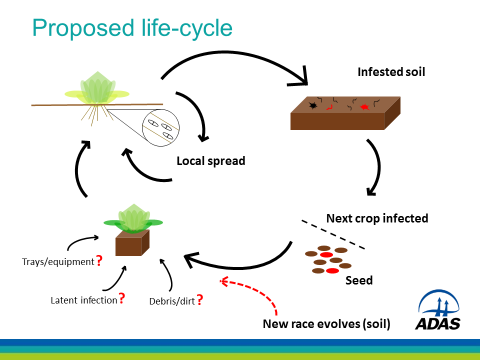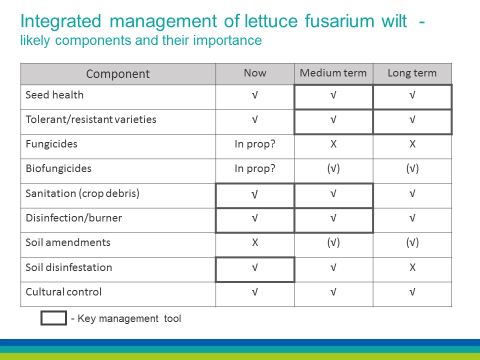Please click here to access the main AHDB website and other sectors.
- Home
- Knowledge library
- Lettuce Fusarium Wilt Workshop
Lettuce Fusarium Wilt Workshop
AHDB hosted a technical workshop in Lancashire to discuss outbreaks of lettuce Fusarium wilt (a new disease to the UK) giving growers the opportunity to address concerns and understand best practice.
To access the presentations shown at the event, please click on the links below:
AHDB Lettuce Fusarium Workshop: Soil Sterilisation Options Using Basamid, Alan Horgan, Certis Europe
Practical measures for reducing the risk and impact of lettuce fusarium wilt, Dr Tim O’Neill, ADAS
The disease has been confirmed on two nurseries in Lancashire with both outbreaks caused by Race 4 of the pathogen, which is also found in the Netherlands, Belgium and Ireland. John Johnson from Enza Zaden gave an overview of the UK situation and confirmed that seed-houses are working hard on breeding programmes for resistance to Fusarium wilt. One affected UK grower gave a timeline on the outbreaks at his nursery. He first observed symptoms in August 2017 but was not aware of the cause of the disease until early autumn; the crops replanted in infested soil became severely affected with Fusarium wilt. Once the disease had been diagnosed, he put in a range of biosecurity and control measures, including cordoning off affected areas as well as using Basamid (dazomet) for soil disinfestation. His experiences were echoed by a visiting Irish grower who had seen the disease at his site in 2016 but believes it was present but unnoticed before that. Due to the high level of infestation at his site, the affected Irish grower has been unsuccessful in controlling the disease.
Tim O’Neill (ADAS Associate Plant Pathologist) provided valuable information for discussion. Tim said that ''All Fusarium wilt diseases are difficult to manage – you need to use integrated control rather than individual measures.''
Fusarium wilt diseases have evolved to be specific to a narrow range of crop species, meaning that lettuce Fusarium wilt affects only lettuce. Tim explained the concept of a ‘disease triangle’ in which essential triggers for a disease outbreak are the presence of sufficient pathogen inoculum, a susceptible host and a conducive environment, with temperature being the key factor in this instance. The soilborne pathogen thrives at 23–25°C so warm summers are a problem, but the pathogen survives at temperatures under 10°C. Fusarium wilt spores are very persistent surviving in soil and crop debris as thick-walled structures. The pathogen can be seed-borne, surviving both externally on the seed coating and internally within the seed, but it is not known the extent to which contaminated seed is responsible for disease spread. Tim proposed this life cycle for Lettuce Fusarium:

©Tim O’Neill, ADAS
The disease can be carried over by symptomless hosts such as spinach, broccoli, cauliflower and wilt-resistant lettuce. Tim also highlighted the need for efficient cleaning and disinfection. Past AHDB-funded work carried out by ADAS had shown that it is easy to kill spores with disinfectants but more difficult to kill mycelium, which needs longer exposure times. Disolite (phenolics) and Unifect G (quaternary ammonium compounds + aldehyde) were the most effective disinfectants (equivalent products are available). Growers are strongly advised to wash off soil prior to disinfection; otherwise, product efficacy is substantially reduced.
Tim proposed the following control measures, urging growers to be vigilant during crop walking:

©Tim O’Neill, ADAS
Soil steaming and Basamid can be used to reduce disease inoculum to depth while propane burning can help kill spores at the soil surface; Tim O’Neill, followed by Alan Horgan of Certis Europe gave advice on ways to get best results from soil disinfestation methods. Growers must take care not to re-infect sterile soils.
There is the possibility that the disease can be transferred to clean sites via symptomless transplants because lettuces generally showed symptoms 10–20 days after planting the lettuce plug plants. James Bean of Crystal Heart Salads told delegates that although technologies are available for tray cleaning these would need to be trialled first to check for efficacy. James was keen to find out if fungicides and bio-fungicides could be applied in propagation to treat latent infection. Kim Parker and Cathryn Lambourne, AHDB Crop Protection Scientists, confirmed that AHDB would be taking potential actives forward for screening in SCEPTREplus.
Although the disease is more of an issue indoors in temperate climates, Andrew Howe, technical manager at L.J Betts who are outdoor lettuce growers, told delegates that he had taken immediate steps, putting in practical measures to reduce the risk of getting and spreading the disease. L.J Betts reviewed their hygiene protocols to include how they handle imported produce in the pack-house and how they deal with waste; they are also having ongoing discussions with seed-houses and propagators
Andy Taylor of Warwick University explained that Race 4 of the pathogen is closely related to Race 1 found in other parts of Europe and has likely evolved from this race. He informed delegates that he is still accepting lettuce samples with suspect wilt symptoms for testing. Molecular testing can diagnose Fusarium wilt and further confirm if outbreaks are Race 4. Continued sampling during 2018 will allow the extent of spread within the UK to be monitored.

